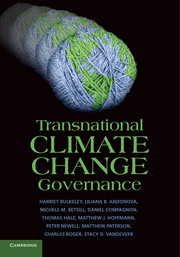Book contents
- Frontmatter
- Contents
- List of Figures and Tables
- Acknowledgements
- Acronyms and Abbreviations
- 1 Introducing Transnational Climate Change Governance
- 2 Mapping the World of Transnational Climate Change Governance
- 3 Theoretical Perspectives on Transnational Governance
- 4 Origins, Agency and the Forms of Transnational Climate Change Governance
- 5 Constructing Transnational Climate Change Governance Issues and Producing Governance Spaces
- 6 The Uneven Geography of Transnational Climate Change Governance
- 7 Understanding Authority and Legitimacy in Transnational Climate Change Governance
- 8 Making a Difference? Tracing the Effects and Effectiveness of Transnational Climate Change Governance
- 9 Conclusions – Looking Beyond Transnational Climate Change Governance
- References
- Index
6 - The Uneven Geography of Transnational Climate Change Governance
Published online by Cambridge University Press: 05 August 2014
- Frontmatter
- Contents
- List of Figures and Tables
- Acknowledgements
- Acronyms and Abbreviations
- 1 Introducing Transnational Climate Change Governance
- 2 Mapping the World of Transnational Climate Change Governance
- 3 Theoretical Perspectives on Transnational Governance
- 4 Origins, Agency and the Forms of Transnational Climate Change Governance
- 5 Constructing Transnational Climate Change Governance Issues and Producing Governance Spaces
- 6 The Uneven Geography of Transnational Climate Change Governance
- 7 Understanding Authority and Legitimacy in Transnational Climate Change Governance
- 8 Making a Difference? Tracing the Effects and Effectiveness of Transnational Climate Change Governance
- 9 Conclusions – Looking Beyond Transnational Climate Change Governance
- References
- Index
Summary
Introduction
Transnational governance by its nature is relatively decentralised and highly dispersed. Literature on the transnational organisations of modes of governance such as networks or PPPs has noted their uneven presence across regions, countries and communities (Andonova & Levy 2003; Andonova 2011; Hale & Held 2011). There is limited understanding, however, about the drivers, patterns and implication of such uneven geographies of climate governance initiatives. In this chapter, we investigate the global geographic patterns that have emerged in the terrain of TCCG. We begin with a brief discussion of the important implications that such patterns may have, and what insights the three analytical lenses used in this book can bring to such an analysis. In the second section of the chapter, we use the three lenses to understand the patterns that appear in the database. We examine the spatial clustering of participation in the TCCG initiatives in our database. As other studies have noted, there is a distinct pattern of North–South relations along certain dimensions of participation, giving rising to a number of normative concerns. However, a rigid North–South understanding of participation in TCCG is also somewhat misleading as we find important regional differences, both in terms of who is engaged in TCCG and where governance activities are carried out. We then consider geographic variation in the kinds of issues that transnational climate change initiatives seek to address and examine the consequences for how TCCG is evolving.
- Type
- Chapter
- Information
- Transnational Climate Change Governance , pp. 117 - 133Publisher: Cambridge University PressPrint publication year: 2014



